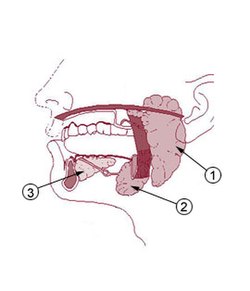Submandibular gland
Submandibular gland is a seromucinous gland with a predominance of serous component. It is stored in the Submandibular triangle. In some cases, it extends beyond the front and back edges of the trigonum submandibulare. Sometimes it also extends into the trigonum sublinguale and can connect with the Sublingual gland.
Ductus submandibularis crosses the lingual nerve when turning to the cranial side of the mylohyoid muscle and continues along the inner side of the sublingual gland. It opens in the caruncula sublingualis together with the ductus sublingualis major.
Histology[edit | edit source]
Submandibular gland is a mixed seromucinous gland with a predominance of serous component. It contains serous alveoli with inserted and annealed ducts, in smaller quantities also mucinous tubules, on which groups of serous cells that resemble crescent moons (Gianuzzi's lunula).
Blood vessels and nerves[edit | edit source]
Branches for arterial supply go from facial artery and lingual artery. The veins converge into facial vein and lingual vein. The lymphatic drainage of this area leads to the submandibular lymph nodes and from them to the deep neck nodes.
Sympathetic fibers come along with arteries, parasympathetic ones come from the facial nerve (n. intermedius) as chorda tympani and from the lingual nerve to the submandibular ganglion and from there rr. glandulares. Sensitive branches originate from the lingual nerve.
Histology Gallery[edit | edit source]
Links[edit | edit source]
Related Articles[edit | edit source]
- Submandibular Triangle
- Facial nerve
- Salivary gland innervation
- Salivary glands
- Parotid gland
- Sublingual gland
External links[edit | edit source]
- Article about glands on the website of Masaryk University
References[edit | edit source]
- ČIHÁK, Radomír – GRIM, Miloš. Anatomie. 2. upr. a dopl edition. Grada Publishing, 2002. 470 pp. vol. 2. ISBN 80-247-0143-X.



